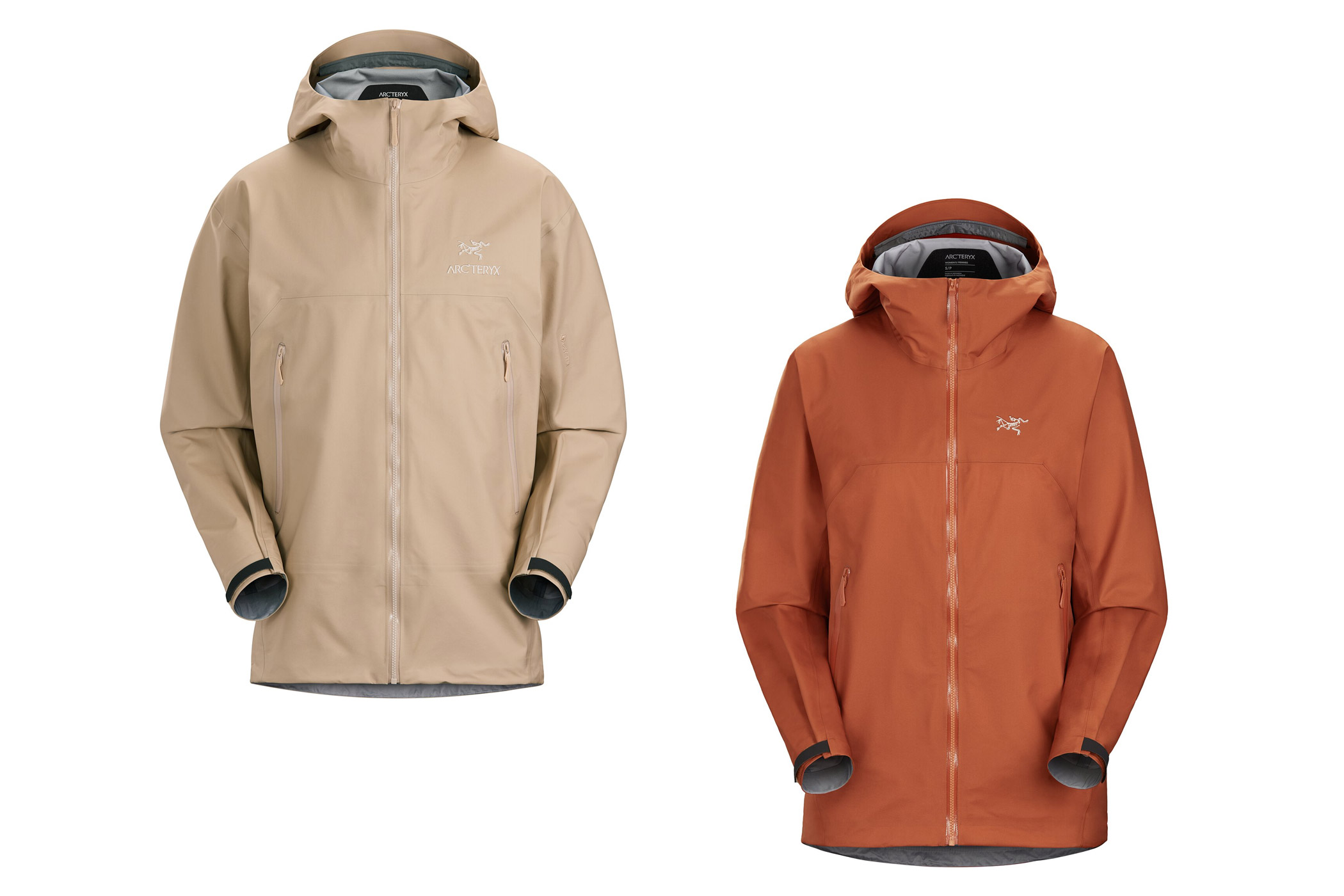We’ve all worn a trash bag in a pinch. And while almost anything is better than being soaking wet, nothing beats a purpose-built rain jacket with the right combination of features and price to meet your needs.
We scoured the internet, spoke with brands, and researched a wealth of online reviews to narrow down the top contenders for the best rain jackets. Then, we tested the best of the best to determine which contenders stood out. We looked at materials, features (waterproof membranes, durability, breathability, packability), price, and more.
Scroll through to see all of our recommended buys or jump to the category you’re looking for. At the end of our list, be sure to check out our comprehensive rain jacket buyer’s guide, as well as our comparison chart. And if you still have rain jacket questions, take a look at our list of frequently asked questions.
The Best Rain Jackets of 2023
Best Overall Rain Jacket
-
Waterproof material
GORE-TEX Paclite 2L -
Waterproof rating
28,000 mm/24 hours -
Breathability rating
15,000 g/m² -
Pit zips
Yes -
Fit
Regular -
Weight
14.5 oz.
-
Integrated stretch panel -
Full torso-length side zips -
PFC-free DWR treatment -
Roomy cut
-
Membrane breathability on the lower end -
Slick-feeling interior
Best Ultralight Rain Jacket
-
Waterproof membrane
GORE-TEX INFINIUM 2L -
Waterproof rating
30,000 mm/24 hours -
Breathability rating
43,000 g/m² -
Pit zips
Yes -
Fit
Regular -
Weight
6.4 oz.

-
Full-featured at UL weight -
Impressive breathability -
Smart patterning reduces seam lines -
Three-way adjustable hood
-
Interior can feel slick -
Left hand zipper
Rain Jackets Comparison Chart
| Rain Jacket | Waterproof Material | Waterproof Rating | Breathability Rating | Fit | Weight |
|---|---|---|---|---|---|
| Outdoor Research Foray Superstretch Jacket |
GORE-TEX Paclite 2L | 28,000 mm/24 hours | 15,000 g/m² | Regular | 14.5 oz. |
| REI Co-op XeroDry GTX | GORE-TEX Paclite 2L | 28,000 mm/24 hours | 15,000 g/m² | Regular | 12.5 oz. |
| Patagonia Torrentshell 3L Jacket |
Proprietary H₂No 3L | 20,000 mm/24 hours | Unpublished | Regular | 13.9 oz. |
| Arc’teryx Beta Jacket | GORE-TEX 3L | 28,000 mm/24 hours | 17,000 g/m² | Active/Slim | 10.6 oz. |
| Montbell Versalite Jacket | GORE-TEX INFINIUM 2L | 30,000 mm/24 hours | 43,000 g/m² | Regular | 6.4 oz. |
| Janji Rainrunner Pack Jacket |
Proprietary Janji 2.5L | 30,000 mm/24 hours | 30,000 g/m² | Active/Slim | 8 oz. |
| The North Face Dryzzle FUTURELIGHT Jacket |
Proprietary FUTURELIGHT 3L | Unpublished | 75,000 g/m² | Regular | 11.9 oz. |
| Rab Downpour Plus 2.0 Jacket |
Pertex Shield 2.5L | 20,000 mm/24 hours | 20,000 g/m² | Regular | 13.2 oz. |
| Outdoor Research Helium Jacket |
Pertex Shield 2.5L | 20,000 mm/24 hours | 20,000 g/m² | Active/Slim | 6.3 oz. |
| Mountain Hardware Stretch Ozonic Jacket |
Dry.Q 2.5L | 10,000 mm/24 hours | 10,000 g/m² | Regular | 10.5 oz. |
| Zpacks Vertice Rain Jacket |
Proprietary Vertice 3L | >20,000 mm/24 hours | 56,000 g/m² | Regular | 7 oz. |
| Outdoor Research Motive AscentShell Rain Jacket |
Proprietary AscentShell 3L | 15,000 mm/24 hours | 30,000 g/m² | Active/Slim | 10.9 oz. |
| Black Diamond StormLine Stretch |
Proprietary BD.dry 2.5L | 10,000 mm/24 hours | 10,000 g/m² | Regular | 11.3 oz. |
| Rab Phantom Pull-On | Pertex Shield 2.5L | 20,000 mm/24 hours | 20,000 g/m² | Active/Slim | 3 oz. |
| Mountain Hardware Exposure/2 Paclite Jacket |
GORE-TEX PACLITE 2.5L | 28,000 mm/24 hours | Unpublished | Regular | 9 oz. |
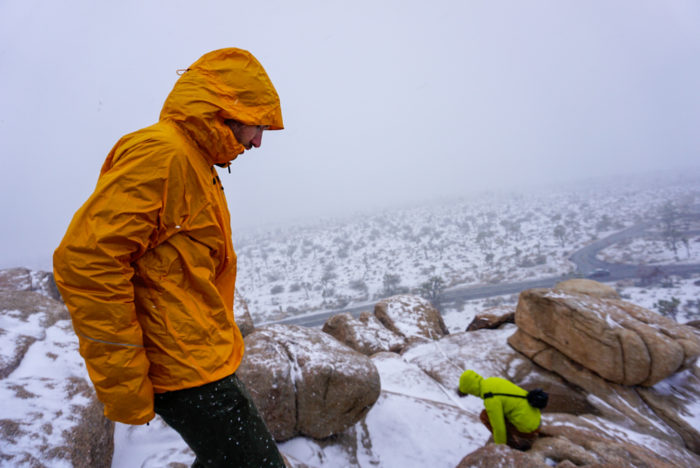
Why You Should Trust Us
Our team of testers has braved storms from the rain-drenched foothills of the Pacific Northwest to the mountains of Colorado to review and publish rain jacket guides for men and women. For this guide, we considered a broad range of uses for rain jackets, and included selections for both city and outdoor use.
Senior Editor Nick Belcaster is no stranger to a little precip. Living and playing in the state of Washington requires either a lot of patience in waiting for the weather to change, or a lot of gumption to get outside anyways. Exploring in the rain can be an exciting change, and having an appropriate rain jacket can make all the difference.
In considering these rain jackets, we consulted online resources, talked shop with brands, and then hit the field to pull our hoods up and let the skies open. From time spent on the Pacific Crest Trail to running laps on ice climbs, rain shells are often put to the test in a wild variety of conditions, and we aimed to review them in a broad spectrum of environments.
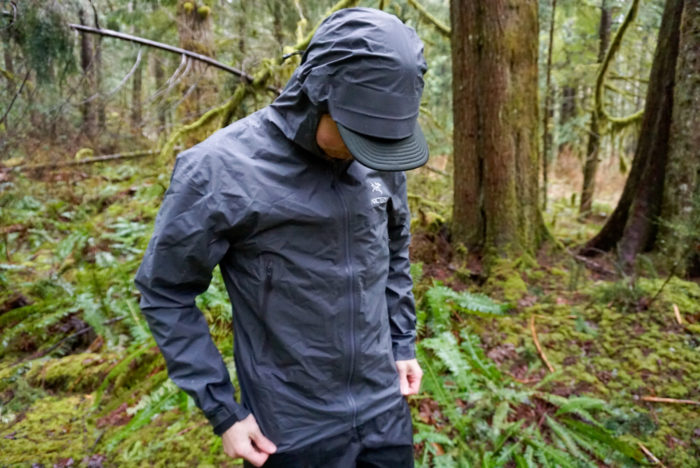
Buyer’s Guide: How to Choose a Rain Jacket
There are a lot of rain jackets on the market. And while having options is great, it can be overwhelming to choose. In this buyer’s guide, we’ll explain the most important factors to keep in mind when deciding on the best rain jacket for your needs.
Waterproofness
Given enough time and pressure, nothing is truly waterproof. Even the yellow rubber slickers that swaddle fisherfolk will eventually yield to enough H₂O, which means a little science is needed in order to understand relative water resistance in rain jackets.
Waterproofness is measured by the amount of water that can pile up on fabric before it leaks over a period of 24 hours. The minimum standard to call something waterproof is 1,000 mm, which should generally be capable of handling everyday front country use, like walking your dog around town in a light drizzle. But for outdoor adventures with severe weather, you’ll want to find a jacket with a waterproof rating between 5,000 mm and 30,000 mm.
Pressure can also lower the waterproofness of your rain jacket, and can be introduced from backpack straps or heavy snow.
- 5,000 mm: Where technical rain outerwear for outdoor adventures begins
- 5,000-10,000 mm: Waterproof under light rain or snow and no pressure
- 10,000-15,000 mm: Waterproof under many conditions, except under pressure
- 15,000-20,000 mm: Waterproof under heavy rain and snow
- >20,000 mm: Waterproof under heavy rain, snow, and pressure
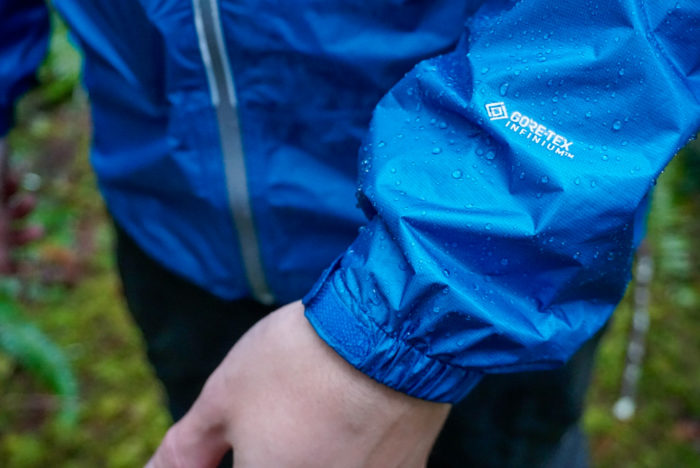
Breathability
As humans, we tend to perspire as we run, hike, or climb in our rain jackets, so having a shell that is breathable should be highly valued. Measured most often by the Moisture Vapor Transmission Rate (MVTR) test, higher values in g/m² denote a better ability to allow perspiration to pass out of a jacket.
Many companies are now creating their own proprietary air-permeable waterproof membranes that boast high breathability ratings, but often in a trade-off for water resistance. These include FUTURELIGHT by The North Face, AscentShell by Outdoor Research, and NeoShell by Polartec.
Jackets intended for high-output activities will have a breathability rating of 20,000 g/m² or more, while lesser ratings between 10,000-15,000 will suffice for in-town use or when packability is the primary goal. The jacket with the highest breathability in our testing was The North Face Dryzzle FUTURELIGHT Jacket at an astounding 75,000 g/m².

Fabric Layers
2-layer
About as simple as simple gets, two-layer jackets utilize a waterproof membrane and outer face fabric to guard against scuffs and scrapes. These jackets often require hanging linings to protect the waterproof membrane from abrasion, which ups the bulk and weight factor, but can also keep the cost down on entry-level pieces.
2.5-layer
Jackets made with 2.5-layer fabrics incorporate a very thin protective lining to the inside of the waterproof membrane, which is typically laminated, screen printed, or sprayed on. These linings often increase the longevity and breathability of the jacket by decreasing the body oils and dirt that can clog the pores of the membrane.
One unfortunate drawback to these jackets is that they often feel clammy against the skin in continuous rain, and lack the moisture-wicking of three-layer jackets.
3-layer
By adding a third wicking textile to the interior of the membrane, three-layer jackets benefit from a significant bump in moisture management, but also typically in price. This is the realm of true all-day-deluge performance jackets, and most often use the big name-brand membranes that have come to dominate the industry, such as GORE-TEX or eVent.
Waterproof Membranes
Waterproof membranes come in a number of flavors these days, but all operate on a similar principle: keep the rain out and keep perspiration from building up inside the shell. The construction of these membranes is often as mechanical as they are chemical, and the two big players today are ePTFE and polyurethane membranes.
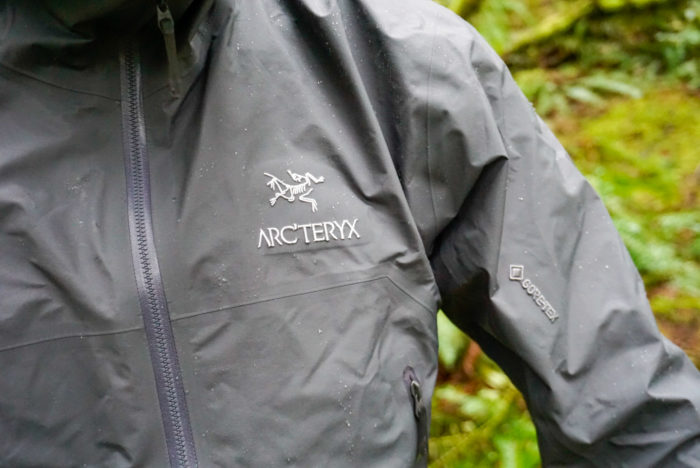
ePTFE Membranes
Best thought of as a piece of plastic stretched very thin, these specialty materials (polytetrafluoroethylene, to be specific) are expanded, creating micropores that act as a filter to inhibit water penetration, but allow water vapor to be expelled. GORE-TEX membranes are created using these materials and processes.
These ePTFE membranes have over 9 billion pores per square inch, each 20,000 times smaller than a water droplet, but 700 times larger than a water vapor molecule. This allows the membrane to resist water from the elements, but diffuse perspiration as it builds within the shell.
Most ePTFE waterproof membranes today also include a thin polyurethane coating on the inside to stop contaminants such as body oils from clogging these pores.

Polyurethane Membranes
The other majority share of waterproof membranes are made using a very thin sheet of polyurethane, which is naturally hydrophilic and maintains breathability through diffusion. These membranes have historically been monolithic, meaning that they lack any pore structure, but new technologies are producing air-permeable membranes which pass air freely.
Because they depend on diffusion to move perspiration from the inside, PU membranes require you to work up a bit of a sweat before they’ll really start to move moisture, which can lead to a slick interior if some mechanical ventilation isn’t employed.
Air-Permeable Membranes
New to the market in recent years, air-permeable membranes take the waterproof nature of polyurethane and create a matrix that allows for gaseous vapor transfer, as opposed to pure diffusion. Opening up the membranes in this way has led to great leaps in breathability, with membranes like The North Face’s FUTURELIGHT boasting a rating of 75,000 g/m².

GORE-TEX Pro
Used in higher-end jackets where maximum protection from wild conditions is needed, Gore’s three-layer Pro membrane is made of several ePTFE membranes bonded together. A >28,000 mm water resistance and 24,000 g/m² breathability put GORE-TEX Pro jackets at the top of the heap. In recent years, multiple versions of GORE-TEX PRO have been produced, including Most Rugged, Most Breathable, and Stretch.
GORE-TEX PACLITE PLUS
When packability is at a premium, Gore’s PACLITE PLUS is a 2.5-layer membrane that cuts down on bulk by stripping out the inner lining and spraying a double layer of polyurethane to increase durability. At >28,000 mm/24 hours of water resistance, PACLITE is plenty waterproof, but its breathability suffers some at 15,000 g/m².
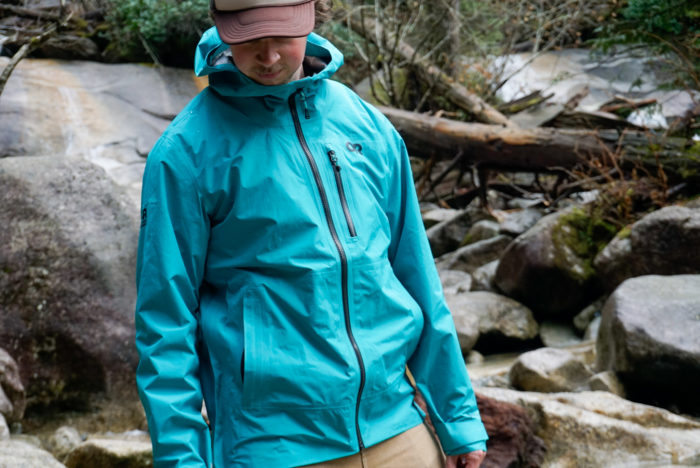
GORE-TEX Active
The airiest of the GORE-TEX offerings, this variation of the Gore membrane boasts a higher breathability rating than other styles, making it ideal for high-exertion activities where moving water out is more important than keeping it out.
eVent
A three-layer membrane that is a close competitor to GORE-TEX, eVent adds even more breathability by coating the pores of its membrane with a water- and oil-shredding chemical that allows the fabric to stay air permeable. 30,000 mm/24 hours water resistance, >20,000 g/m² breathability. While eVent made a big splash when it arrived, today it has by-in-large disappeared from the market in favor of new air-permeable membranes.
Polartec NeoShell
Hailed when it first came out as revolutionary for its breathability (30,000 g/m²), Polartec’s NeoShell is better suited for high-perspiration activities where users are more worried about the moisture coming from within than from out. Its water resistance is mid-tier at 10,000 mm/24 hours.

Pertex Shield+
Using a polyurethane film membrane, Pertex Shield+ is able to achieve a good balance of water resistance and breathability at 20,000 mm and 20,000 g/m², respectively. Produced as a 2.5-layer fabric, jackets made with these membranes can sometimes be overwhelmed by perspiration and feel slick to the touch.
Proprietary Membranes
These include numerous specialty textiles that are created directly for manufacturers to their specifications, which allows them to fine-tune their membranes as well as keep overhead costs down and produce more affordable rainwear. Examples include Outdoor Research’s AscentShell technology, Black Diamond’s BD.dry, and many more.
We’ve found that rain jackets made with proprietary membranes are often significantly less expensive than jackets using name-brand membranes.
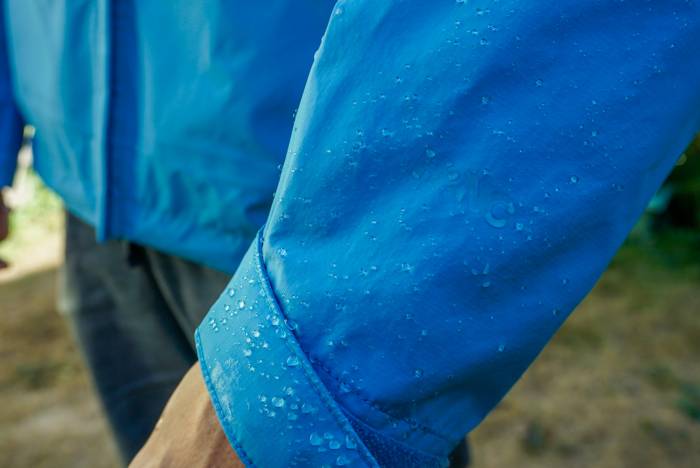
Durable Water Repellent Finish (DWR)
The first line of defense for a rain jacket, a durable water-repellent finish (DWR) is a hydrophobic coating that gives it that ‘duck’s back’ look of rain beading away harmlessly. This keeps water from overwhelming the waterproof membrane and prolongs its ability to stay waterproof.
DWR coatings also affect the ability of the jacket to breathe, as a wetted-out face fabric will inhibit the jacket’s ability to expel moisture. Abrasion, oils, and trail funk can all degrade the coating, so keeping your rainwear clean and re-waterproofed is the best way to ensure that your jacket continues to function at peak performance, as we discuss below.
Historically made from environmentally harmful chemicals known as perfluorocarbons (PFCs), many companies are now working on using PFC-free DWR finishes in their rain jackets. Patagonia has pledged to use a PFC-free DWR in all of its outerwear by 2024, and REI recently announced that it would soon no longer carry products from brands that continue to use the chemicals. We are happy to see this trend spreading throughout the industry.
Comfort
It’s important that your rain jacket moves comfortably with you and does not overly restrict your movement. A comfortable rain jacket will keep you dry without feeling annoying or cumbersome.
A growing trend has been incorporating built-in stretch into rain jackets, which greatly increases their abilities where high mobility is needed. Jackets we reviewed like the Black Diamond StormLine Stretch and Mountain Hardware Stretch Ozonic Jacket incorporate stretch and will move with you outdoors.
Small features usually define the overall comfort of a rain jacket. For example, a hood that fully blocks peripheral vision will not be comfortable to use. Ideally, your rain jacket will minimally limit your range of motion, and the interior lining will feel good against your skin.
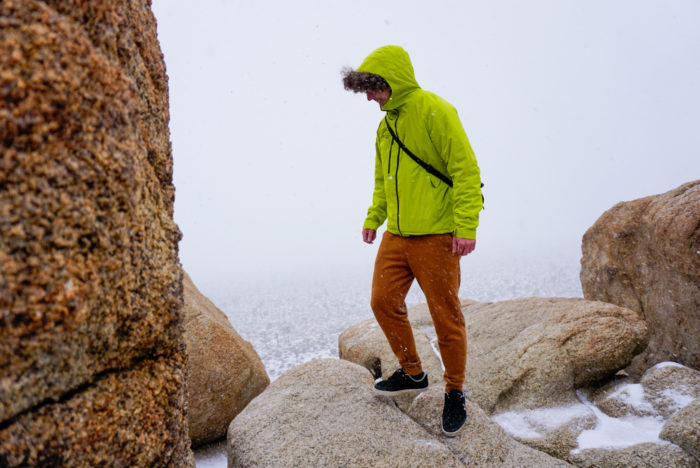
Weight & Packed Size
Most people agree weight is an important consideration for any piece of outdoor gear. If you’re going to be carrying your rain jacket in a pack when it isn’t in use, you want it to be as light and compact as possible — without sacrificing usability. Many lightweight rain jackets, like the Montbell Versalite, weigh less than a pound without sacrificing durability and functionality.
Many rain shells stuff easily into their own pockets and become barely larger than a baseball. Once packed down, it’s nice to have an external clip-in loop on the stuff sack — especially for multi-pitch rock climbing or backpacking. If your rain jacket packs down conveniently, you’re more likely to bring it along and have it when it’s needed most.

Zippers, Pockets, and Seams
It’s nice to have a well-placed pocket or two in your rain jacket. However, more pockets mean more material, and more material means increased weight and decreased packability.
Also, pockets create seams that may also decrease the waterproof capability of the jacket. Still, it’s nice to at least have two hand pockets to keep your hands warm and dry in a storm. Waterproof zippers on pockets and front zippers can add increased water resistance and protect your valuables inside. Also, rain jackets will often incorporate underarm zippers to increase ventilation.
Sewing together a rain jacket introduces hundreds of holes into the fabric, so most incorporate taped or bonded seams to ward off leaks. Seam tape can be added to all seams, or sometimes only essential seams, in order to save weight.

Hood
Some rain jackets have hoods that double as a convenient stuff sack. Generally, if it’s raining hard enough to warrant a rain jacket, you’ll probably also have the hood up.
A well-designed hood should be strategically designed to offer full protection without limiting peripheral vision. Adjustments can include a simple drawstring at the rear of the hood to pull the crown out of your eyes, as well as side profile adjustments for peripheral coverage, and wire-stiffened brims to keep rain from draining into the hood.
Finally, it’s also important to ensure that your hood will fit over any helmet you may be wearing. Typically seen in more sport-specific or hardshell jackets, helmet-compatible hoods provide a bit of extra space internally to accommodate your protective headwear.
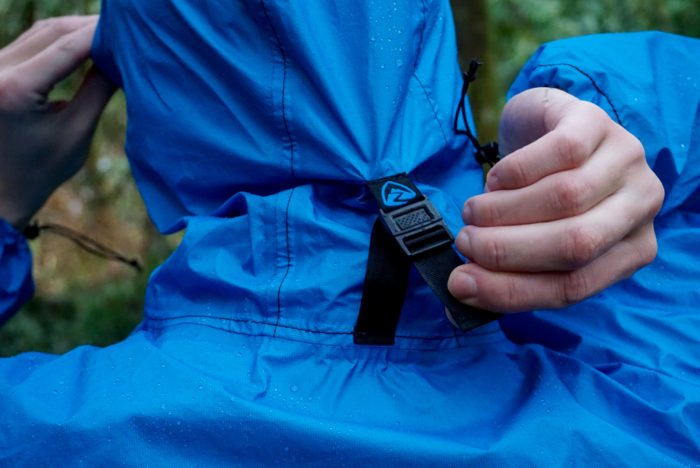
Extra Features
Ultimately, a rain jacket’s sole purpose is to keep moisture out. However, some jackets also include some extra features that add further value.
Some jackets come with features such as handwarmer pockets, large pit zips, and a roomy cut that allows space for warm layers underneath. These can be important to consider, as often rain jackets will be tailored to a certain range of uses. For example, a rain jacket that is crafted for city use will likely forgo pit-zips and instead provide some roomy hand pockets — while a shell meant for all-day hiking should sport an accommodating profile and adjustable hood cinches.

Sustainability
In striving to create the most waterproof membrane, the outdoor industry created a number of unsustainable practices which are slowly beginning to be rectified: using recycled materials, PFC-free DWR finishes, and ensuring sustainable practices are used during production.
Being Bluesign certified means that the fabric used in the jacket has passed an independent approval process to ensure that they are safe for the environment and consumers. A similar process is used in being Fair Trade Certified, where producers must ensure sustainable livelihoods for textile workers.
The most sustainable rain jacket in our review was the Patagonia Torrentshell 3L Jacket, which utilizes a 100% recycled face fabric, is Fair Trade Certified sewn, and is Bluesign approved.

Durability and Caring for Your Rain Jacket
A rain jacket is designed to be exposed to the elements, and a good one will do its job without falling apart. As rain jackets become lighter, users should expect a dip in durability, too.
However, on this list, we’ve included rain jackets that are both lightweight and reliable. A jacket that is abrasion-resistant will have much greater overall longevity. Purchasing a shell that utilizes a higher denier face fabric, such as the Arc’teryx Beta Jacket, will greatly increase its durability over time.
Often overlooked, regular upkeep of your rain jacket is essential to keeping the waterproof membrane happy and working as it was designed. When body oils and grime clog the interior pores, the breathability suffers, and a worn-away DWR finish does little to keep a jacket from wetting out. A quick and easy way to breathe some life into your DWR is a brief cycle in the dryer on medium heat.
When a more thorough cleaning is in order, begin by washing your rain jacket with a detergent that is made for waterproof fabrics, such as Nikwax Tech Wash. We’ve found that this will cleanse the waterproof membrane and allow it to function as designed.
You can go a step further by reapplying a fresh coat of DWR such as GEARAID Revivex Durable Water Repellent Spray, and then turning the jacket inside-out and drying it on high heat to set. This is a common fix and with frequent reapplication, it will keep water beading off your jacket when it counts.
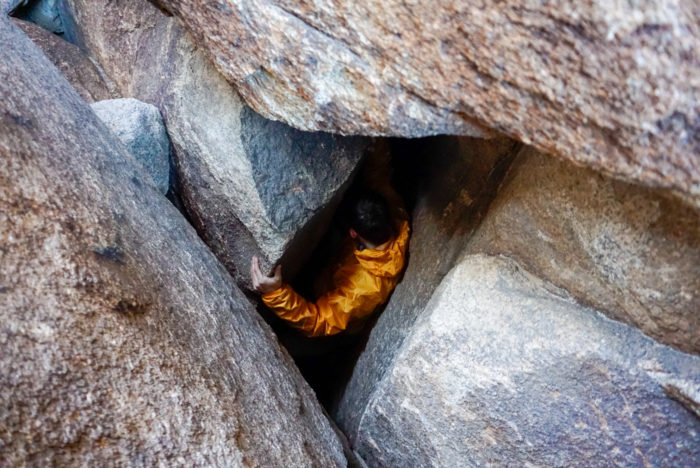
FAQ
The best waterproof jacket is one that fits well, meets your needs, and provides reliable waterproofing. On this list, we have included several high-quality rain jackets.
When deciding which one to purchase, consider factors including the jacket’s waterproof rating, weight, durability, and extra features.
GORE-TEX is the gold standard for waterproof fabric. When undamaged and in good shape, GORE-TEX-treated fabrics will keep out any liquid water that lands on the surface.
However, over time, the quality of the waterproofing of GORE-TEX will degrade, and it will no longer perform like new. Most GORE-TEX materials have a waterproof rating of 28,000 mm.
It’s wise to always go into the outdoors prepared with a rain jacket. Many rain jackets are light and packable, so you’ll hardly notice them in your pack during the hike. In wet and cold conditions, a good rain jacket can keep you comfortable and safe.
Waterproof membranes in rain jackets degrade slowly, but are sensitive to becoming dirty and clogged with sweat and dirt. Often, a jacket still retains much of its original waterproof ability, and only needs to be cleaned with a waterproof fabric-safe detergent and re-waterproofed with a new DWR finish.
Wetting out occurs when the face fabric of a rain jacket becomes overwhelmed by water from the outside, saturating the outer face and limiting the ability of the waterproof membrane to do its job.
This can occur when a DWR finish has worn out, or external pressure from a heavy pack presses the moisture into the fabric. Frequent washing and re-waterproofing is the best bet to avoid wetting out.
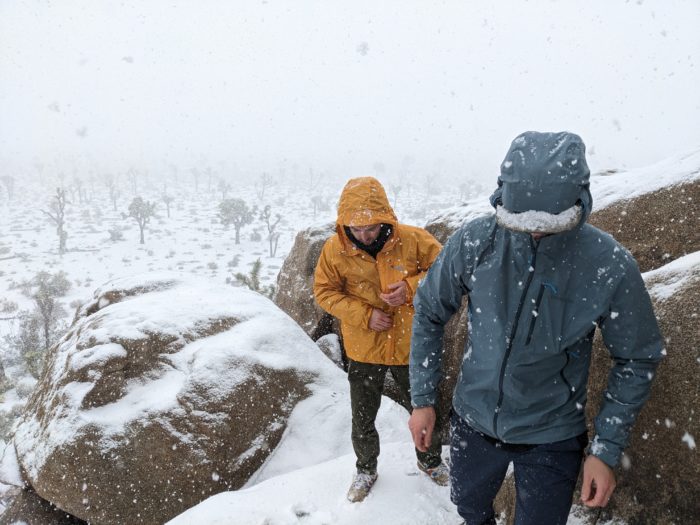
Rain jackets are designed to keep water out while still allowing your body’s moisture to escape as vapor. Unlike a trash bag or plastic poncho, rain jackets are semipermeable and designed to keep you both cool and dry at the same time.
Still, a rain jacket is certainly less breathable than other kinds of layers, and you can expect some heat and moisture to get trapped underneath.
Strictly speaking, rain jackets are not usually designed with insulation. Most of the jackets we’ve recommended on this list are not insulated. The main job of a rain jacket is to protect you from rain, snow, wind, and other adverse weather. While rain jackets will add a little warmth, other layers such as fleece jackets and puffies provide much more and can easily be worn underneath a rain jacket.



